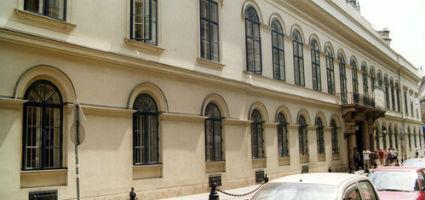2024. April 20. Saturday
Museum of Literature Petőfi - Budapest
 |
Address: 1053, Budapest Károlyi u. 16.
Phone number: (1) 317-3611
E-mail: muzeuminf@pim.hu
Opening hours: Tue-Sun 10-18
|
The exhibition has closed for visitors.
2003.01.30. - 2003.03.20.
Museum tickets, service costs:
|
Ticket for adults
(valid for the permanent exhibitions)
|
600 HUF
|
/ capita
|
|
Ticket for adults
(valid for the temporal exhibitions)
|
800 HUF
|
/ capita
|
|
Ticket for students
(valid for the permanent exhibitions)
|
300 HUF
|
/ capita
|
|
Ticket for students
(valid for the temporal exhibitions)
|
400 HUF
|
/ capita
|
|
Ticket for pensioners
(valid for the permanent exhibitions)
|
300 HUF
|
/ capita
|
|
Ticket for pensioners
(valid for the temporal exhibitions)
|
400 HUF
|
/ capita
|
|
Ticket for families
(valid for the permanent exhibitions)
|
1100 HUF
|
/ family
|
|
Ticket for families
(valid for the temporal exhibitions)
|
1500 HUF
|
/ family
|
|
Guide for students
(accompanied by a museum pedagogist )
|
2500 HUF
|
/ group
|
In the ancient times coins were only used for payment, but later they served for the commemoration of certain events or persons. During the renaissance the coin art was not only fast developing, but the old coins began to be collected as well. By the 16th century significant nobiliary collections had been formed. Vienna became the center of the university training of numismatics. In the 19th century there were a good number of experts and researchers in the numismatics field. Catalogues, periodicals and monographies were published.
The function of coins further extended by the turn of the century. The coin sculptors found more and more occasions for commemoration. They made coins even without any orders. The style of the works was not influenced by the either the function or those ordering the coins. The special symbols of the inscriptions derived from nature and wwere shaped differently in each case. At this time the technique of molding was introduced as an alternative to minting.
The work of the Hungarian coin-makers was gradually growing from the beginning of the 20th century. By the 1940'ies the careful formation of the details, the deciplined composition and the artistic effect was characterizing the works. From the second half of the century subjective experiences, inner and outer spaces and literary illustrations were inscripted in the coins. Series of certain thems were also made.
Not only the contents but the shapes of the coins have also altered. The new solutions changed the character of the former works. The number of the orders grew, the shapes became simplified and the polished surfaces appeared. The shape of the coins was seldom circular, and the borderline between the style of small plastic works and coins got smeared. Commemorative coins were scarcely put in the plans and there was a tendency to avoid the figurative styles.
Today the coin sculptors do not necessarily adhere to the classical rules and restrictions of coinage. They experiment with changes regarding both the content and the shapes. At the same time the traditional coinage got also renewed.
Our exhibition does not endevour to give a summary of the history of coinage, but to first of all give a taste of the coins made in the 19-20th centuries.
Gabriella Nyerges
The function of coins further extended by the turn of the century. The coin sculptors found more and more occasions for commemoration. They made coins even without any orders. The style of the works was not influenced by the either the function or those ordering the coins. The special symbols of the inscriptions derived from nature and wwere shaped differently in each case. At this time the technique of molding was introduced as an alternative to minting.
The work of the Hungarian coin-makers was gradually growing from the beginning of the 20th century. By the 1940'ies the careful formation of the details, the deciplined composition and the artistic effect was characterizing the works. From the second half of the century subjective experiences, inner and outer spaces and literary illustrations were inscripted in the coins. Series of certain thems were also made.
Not only the contents but the shapes of the coins have also altered. The new solutions changed the character of the former works. The number of the orders grew, the shapes became simplified and the polished surfaces appeared. The shape of the coins was seldom circular, and the borderline between the style of small plastic works and coins got smeared. Commemorative coins were scarcely put in the plans and there was a tendency to avoid the figurative styles.
Today the coin sculptors do not necessarily adhere to the classical rules and restrictions of coinage. They experiment with changes regarding both the content and the shapes. At the same time the traditional coinage got also renewed.
Our exhibition does not endevour to give a summary of the history of coinage, but to first of all give a taste of the coins made in the 19-20th centuries.
Gabriella Nyerges